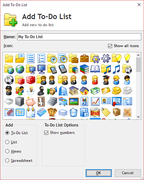Paper vs. Computer To-Do List
All of us have things we need to do in our day to day life. We can remember in our mind the things we need to do but it is definitely not the best way to be managing them. Often it’s not going to work, the consequence will be you miss or simply forget something.
This is especially true when you have many things to do over a period of time. What makes things even worse is when you have to prioritize and remember to do the things at or prior to a desired time or event.
Long before computers were invented people realized the shortcomings in remembering things to do and started writing the things down on paper (or whatever material they used).
I can say with confidence this helped them manage and prioritize the things they needed to do and get organized. At the time this is logically the better alternative than remembering the list.
However, having a written list of things to do has its downside as well; security, flexibility, maintainability, expandability, redundancy, etc. are some of the areas paper to do lists poses challenges to people using them.
With the advent of computers and advancements in technology, paper to do lists have lost the ground to computers to do lists. This is largely due to the many advantages that computer to do lists have over the paper to do lists.
People can choose whatever means or system they are comfortable with in managing their things to do but in my opinion they are better served by using a computer to manage their to do lists.
In this article, I will highlight the differences and benefits of having a computer to do list compared to paper to do list.
I am tempted to do an apples to apples comparison of paper and computer to do lists by discussing computer to do lists in the context of having a written to do list in a notepad or word pad but that will not serve the purpose I embarked on in this article which is to really talk about how the latest computer technology leverages management of to do lists and benefits people who keep to do lists.
To this end I will discuss computer to do lists in the context of to do list software. For simplistic reasons in this article let us assume a computer means a desktop or laptop running Microsoft Windows operating system, but if you wish you can extend this assumption to computers running other operating systems and smart phones.
Although I am not very familiar with non-Windows operating systems I am guessing there are some good to do list software that can be used on those operating systems.
Personally, I’ve used to do list software on smart phone and it is fundamentally no different than a basic to do list software. Now not all the benefits I list in this article can be found in every to do list software, but the majority of benefits can be found in any good to do list software.
I feel it is easy to compare paper to do list with computer to do list, understand and appreciate the benefits of computer to do lists when they are shown in a table, so I will list below features and benefits a good to do list should have and whether paper or computer to do list share those features and benefits.
| Benefit | Paper | Computer |
| Ability to remind about upcoming task (reminder) | - | YES |
| Ability to have automatic recurring task | - | YES |
| Ease of updating to do list | YES | YES |
| Ease of re-organizing to do list | - | YES |
| Unlimited items in to do list | - | YES |
| Use of colors or visual aids to indicate priority or status of tasks | - | YES |
| Grouping of tasks and reusing the groups | - | YES |
| Unlimited groups of tasks | - | YES |
| Protection of to do list | - | YES |
| Ease of sharing to do list | - | YES |
| Link to documents or files | - | YES |
| Ease of backup and restore of to do list | - | YES |
| Ease of use (duplicate, delete, rename, edit task, etc.) | - | YES |
| Shelving or hiding of completed or deleted tasks | - | YES |
| Ability to add notes to task | - | YES |
| Ability to sort to do list | - | YES |
| Ability to filter to do list | - | YES |
| Ability to search to do list | - | YES |
| Ability to create nested groups of tasks | - | YES |
| Ability to integrate with office productivity and other software | - | YES |
| Ability to reuse the to do list | - | YES |






